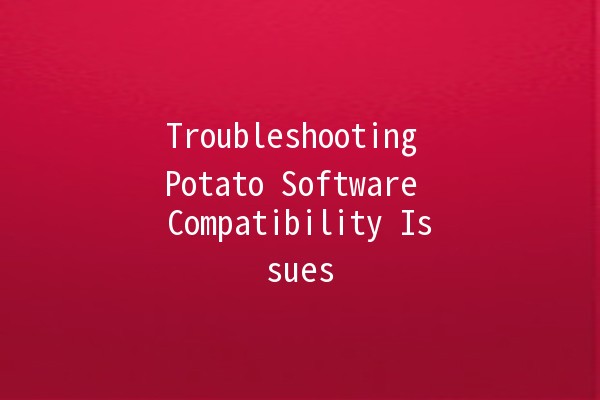In today's digital landscape, software compatibility issues can be a major hurdle for users and organizations alike. Specifically, when it comes to tools like Potato software, addressing compatibility problems is crucial to maintaining productivity and streamlining processes. This article aims to equip you with practical strategies to tackle these issues effectively, boosting your productivity and ensuring seamless software experiences.
Understanding Software Compatibility Issues
What is Software Compatibility?
Software compatibility refers to the ability of a software application to perform its intended functions on a particular operating system, hardware, or in conjunction with other software applications. When compatibility issues arise, users may experience reduced functionality, crashes, or even complete failures of the software.
Common Compatibility Issues with Potato Software
Potato software may encounter various compatibility issues due to:

Practical Solutions to Enhance Compatibility
Here are five actionable techniques you can implement to solve compatibility issues with Potato software:
Explanation: Keeping your operating system up to date is one of the most effective ways to ensure compatibility with Potato software. When the OS is updated, it can accommodate the latest features and fixes offered by applications.
Application Example: If you're using Windows, regularly check for updates through Windows Update. Install the updates and reboot your computer. Afterward, open Potato software to see if it now functions without issues.
Explanation: Each software application, including Potato, has specific system requirements. Ensure that your hardware meets or exceeds these requirements for optimal performance.
Application Example: Check Potato software’s official website for its minimum and recommended system requirements. For instance, if it requires 8 GB of RAM but your system has only 4 GB, consider upgrading your memory.
Explanation: Other software on your system may conflict with Potato, causing unexpected issues. Identifying and managing these conflicts is crucial.
Application Example: To troubleshoot, perform a clean boot of your operating system by disabling all nonessential startup programs. Once the system is in a clean boot state, run Potato software to see if the issues persist. Gradually reenable startup programs to identify the conflicting application.
Explanation: Outdated drivers can lead to numerous compatibility issues, especially with graphicintensive software or those requiring specific hardware functionality.
Application Example: Visit the manufacturer’s website for your graphics card or other critical hardware components, and look for driver updates. Install the latest driver versions, restart your computer, and relaunch Potato software.
Explanation: Network configurations can impact Potato software’s ability to connect to required services online. Ensuring correct settings can resolve connectivity issues.
Application Example: Check if your firewall or antivirus software is blocking Potato software. Temporarily disable these security measures to determine if they are the cause. If the software works correctly when they are disabled, configure them to allow Potato while maintaining overall security.
Frequently Asked Questions
What are the potential causes of Potato software compatibility issues?
Compatibility issues can arise from outdated operating systems, insufficient hardware specifications, software conflicts, outdated drivers, and incorrect network configurations. Identifying the specific cause is key to implementing effective solutions.
How can I check if my system meets the requirements for Potato software?
To check system requirements, visit the official website of Potato software. Look for sections that detail the minimum and recommended specifications for the operating system, hardware, and any other software dependencies needed.
What should I do if Potato software crashes on startup?
If Potato software crashes upon startup, try running it in compatibility mode. Rightclick the application icon, select Properties, navigate to the Compatibility tab, and choose a previous version of Windows. This can sometimes help in resolving issues caused by operating system conflicts.
Is it necessary to uninstall my antivirus for Potato software to work?
Not necessarily. Instead of uninstalling your antivirus software, check the program's settings to see if Potato software is being blocked. You can often configure exceptions or allow sites and applications without compromising your system’s security.
What is the best way to manage software updates for Potato software?
To manage updates effectively, enable automatic updates on Potato software if this option is available. Alternatively, check the official website or user forums regularly for announcements regarding new updates and patches critical for maintaining software functionality.
How can I report ongoing compatibility issues with Potato software?
Most software developers provide a support channel, such as a help desk or customer service email. Reach out to Potato software's support team with detailed information regarding your compatibility issues, including screenshots and system specifications, to facilitate a quicker resolution.
Essentially, addressing software compatibility issues, especially with applications like Potato, can significantly enhance user experience and productivity. By following the recommended strategies and practices outlined in this article, you will be wellequipped to troubleshoot and resolve compatibility challenges effectively. For continued updates and support, consider engaging with community forums or the software support team to stay informed about best practices and solutions.